Ericksonian Hypnosis is a method of indirect hypnosis named after Dr. Milton Erickson. A prominent American psychiatrist and psychologist, Erickson is widely regarded as the “father of hypnotherapy”. His discoveries have influenced a wide spectrum of therapy from strategic family therapy to neuro-linguistic programming.
Dr. Erickson found that indirect suggestion could result in therapeutic behavioral change. He preferred to converse with clients using metaphors, contradictions, symbols, and antidotes to influence their behavior rather than direct orders.
As a patient himself who suffered extreme pain after contracting polio at an early age, he thought it critical to “put yourself in the patient’s shoes” and truly understand the client’s present situation.
Unlike Freud – who encouraged self exploration – Erickson adopted a form of brief therapy where a patient’s past history is not the focal point of change.
Recalling one conversation with a patient with Obsessive Compulsive Disorder who showered a dozen times a day, he asked the patient about the present rather than their past. Specifically he would ask about the process: “Do you wash from the neck down, or do you start with your feet and wash up? Or do you start with your head and wash down?” He made it a point to show the patient that he was really interested. The patient, who had undergone 5 years of traditional psychoanalysis prior was quickly cured with Ericksonian hypnosis.
Hypnotism History & Etymology
The word “Hypnotism” was coined by a Scottish medical surgeon named James Braid. In a letter to The Lancet dated 1845 Braid says:
“I adopted the term “hypnotism” to prevent my being confounded with those who entertain those extreme notions, as well as to get rid of the erroneous theory about a magnetic fluid, or exoteric influence of any description being the cause of the sleep. I distinctly avowed that hypnotism laid no claim to produce any phenomena which were not “quite reconcilable with well-established physiological and psychological principle”
Dr. Braid was referring to a French fringe magnetist group that had been using the terms “hypnotique, hypnotisme, and hypnotiste” from 1820 onward.
The Unconscious Mind
Braid defined hypnotism as a state of extreme focus. However, Erickson knew from experience that patients in physical or mental pain are unlikely to be able to focus at all. Thus, rapid hypnotic inductions are likely to be met with resistance and ultimately fail.
Erickson believed that trances happen every day to varying degrees – for example the mind wanders during a commute to work, during meetings, and day dreaming in general. Athletes even enter a trance sometimes referred to as “flow” or “runner’s high”.
Even if the subject is not in a deep trance, Erickson thought the unconscious mind could still be listening. He could make an indirect suggestion that, whether the patient realized it or not, would result in therapeutic change in the patient.
A frequent jokester, Erickson was able to use humor in his conversations with patients as well. In fact his books are scattered with puns and subtle jokes. But this was not just to lighten the situation of patient affected by serious addiction and mental condition– it was deeply strategic.
By catching them off guard he was able to open the unconscious mind for change. This ties into his confusion technique.
Stephen Brooks live Streaming Interactive Online Diploma in Compassionate Ericksonian Hypnotherapy. Accredited Practitioner Diploma Training for students wishing to qualify as hypnotherapists and be registered to offer hypnotherapy to clients / patients. ENROLING NOW
Indirect vs Direct Hypnosis
Indirect hypnosis is a subtle, respectful method utilizing body language, stories, metaphors, and other hypnotic techniques to improve patient outcomes. Erickson championed indirect hypnosis as a more ethical and effective alternative for clinical settings than direct hypnosis.
Direct hypnosis would explicitly order a subject to enter a trance or change their behavior. Though direct hypnosis can be a powerful tool, it is commonly met with resistance and is better known as a method for self-hypnosis.
| Traditional Hypnosis | Erickson’s Approach |
| Authoritative | Permissive |
| Direct | Indirect |
| Resistance | Accommodating |
| “You will lose weight” |
“You might wish to discuss the alternatives to eating, if you are ready to do so” |
For example with direct hypnosis one might say, “You will fall asleep now”. On the other hand, with indirect hypnosis a therapist could say, “You might like to close your eyes, if you wish to relax.”
The former, is embarrassing for both the therapist and the client, as it is often met with resistance and failure. The client knows the hypnotist is trying to put them into a trance, and with that comes natural fear, skepticism, and resistance. With the indirect method it is up to the patient to decide which suggestions they choose to follow.
Until Erickson, the prevailing thought was that direct hypnosis was the best way to get a subject to enter a trance. He believed that one cannot force the unconscious mind to change, but metaphors, contradictions, symbols can create openings.
Direct hypnosis is ethically questionable because this authoritative approach takes power away from the client, whereas indirect hypnosis empowers them. And from a therapeutic standpoint, the effect will be more powerful if it is the client that decides to change themselves from within with the help of indirect suggestion.
Milton Model
Richard Bander and John Grinder set out to discover what made some psychotherapists more successful than others. They assembled their findings into a methodology called “neuro-linguistic programming”. Erickson was one of several therapists and communicators examined and they created a model of his methodologies which they called the ‘Milton Model’. This model is often taught as an adjunct to NLP courses by organisations who mainly teach NLP. Likewise NLP skills and techniques are often taught as an adjunct to hypnotherapy courses by organisations who mainly teach hypnotherapy.
NLP organisations tend to teach the NLP Milton Model of hypnosis (if they teach hypnosis), and Ericksonian Hypnosis organisations prefer to teach the work of Ericksonian hypnotherapists such as Ernest Rossi, Jay Haley, Bill O’Hanlon, Stephen Gilligan, BHRTI founder Stephen Brooks and others. This approach to teaching Erickson is generally more comprehensive than the Milton Model, which is primarily a model based on language patterns.
The Ericksonian Foundation run by Erickson’s family have avoided associating itself with NLP but the BHRTI believes that NLP has a lot to offer, but however, has always insisted that to be truly effective, the NLP skills and techniques modeled from Erickson should always be taught and applied within the context of hypnosis, as this is how Erickson originally intended, and not taught as separate NLP techniques without hypnotic trance.
The Milton Model focuses on three aspects:
- Rapport – Building an empathetic connection with the client. In addition to verbal communication this may include “mirroring” the subjects body language while avoiding “mimicry” which could have opposite effect.
- Overloading conscious attention – By distracting the conscious mind with vagueness and ambiguity, one is able to open the unconscious to change. See also, confusion technique and handshake induction.
- Indirect communication – Clients can only meet a direct orders in two ways: with acceptance or dismissal (most likely the latter). Indirect suggestion is a more subtle and successful way to invoke change. See also, indirect hypnosis.
About Milton Erickson
Milton H. Erickson grew up on his parents’ farm in Wisconsin. The influence of this environment on him is clear, as he often used the farm in stories and metaphors.
At the early age of 17 Erickson was paralyzed with polio. Little did he know this difficult event would shape the rest of his life.
While bedridden, the boy could do little more than move his eyes and hear. Speaking was difficult and moving was out of the question.
From this experience he learned to read the body language and indirect behavior of his family members and nurses. He listened intently as well.
For example, if his parents confronted a sibling about completing their homework, he could see his sister’s body language say “no” when they spoke the word “yes.”
After graduating from the University of Wisconsin with a MA in psychology as well as an MD, Erickson continued his medical training at various hospitals in New England and Michigan.
He went on to become the Clinical Director at the University of Arizona 1948. He left one year later to start a private practice, partially due to paralysis which had confined him to a wheelchair. He served as a consultant to the US Olympic Rifle Team and the US Government in World War Two.
During this time was well known in clinical circles. However, it was not until 1973 – when former student Jay Haley published Uncommon Therapy – that Erickson became famous to the rest of the world. He began offering seminars to teach the principles of his work, until he died in 1980.
Self Hypnosis
Bedridden and given until the morning to live at the age of 17, Erickson requested a mirror be set up in his room. He was determined to see another sunset, as reflected through the mirror. The next morning he was still alive, and asked his father why the fence and trees had been removed outside. Supposedly, he had been concentrating on the mirror so long that he had not realized his unconscious mind was able block out all of the objects between himself and the sunset!
Polio left Erickson paralyzed and he faced extreme bouts of pain throughout his life. He adopted a self-hypnosis routine to effectively manage the pain whereby he would sit in a chair pushing his spine into the back for an hour each morning.
Erickson would sometimes hypnotize himself during client sessions to increase his awareness and better listen to clients. Self-hypnosis by a therapist during a session was and still is highly controversial.
Ericksonian Hypnotherapy Techniques
Encouraging Resistance
Again in a departure from classic psychotherapy, Erickson discouraged the authoritative use of “tell me about…” Instead he would encourage the patient to withhold information and only discuss what they wished to. This passive method helped clients ultimately share more information with him. The client was empowered rather than the therapist. They felt that they needed to save this special ability to withhold information for something important later. By the end of the conversation they had told him everything.
A famous example of using resistance and a “double bind” occurred when Erickson was a boy. One day Erickson was helping his father coax a stubborn calf into the family barn. Try as they might to pull the calf into the barn, it didn’t budge. He realized that the calf wished to resist, accepted it, and pulled the opposite end on it’s tail – away from the barn. The new input of the boy pulling on the tail negated the father pulling on the head and the calf went into the barn.
He used this as a classic psychological example of a double bind – where the subject becomes overwhelmed and is emotionally “pulled” in two conflicting directions. Thus, the confused individual successfully accepts one form of resistance and fails to respond to the other.
In the context of family therapy, if a family member is resisting engaging in conversation he might ignore that member until they finally respond out of frustration.
Seeding Ideas
Using indirect hypnosis Erickson would “seed ideas” into the unconscious mind via metaphors and stories. A less subtle example would be, “have you ever been in a trance before?” Now, the idea of a trance is in the mind even though the subject is not in one yet.
Handshake Induction
One of the most famous hypnosis techniques is the handshake induction. As the first interaction with a client, and a common everyday occurrence Erickson proved it was a subtle way to change the mind’s accepted behavior. When someone performs a handshake their mind is virtually on autopilot – you may have never realized it’s a trance. It is the most widespread social norm in the world to shake hands at the beginning of a meeting; we don’t even think about it. By interrupting this subconscious process, Erickson was able to open the mind for suggestion. This is a classic example of “pattern interruption.”
Erickson’s handshake technique is well documented in his books and by those that have met him. He began with a strong, normal shake to begin the induction. Then he would interrupt the process by loosening the strength of the grip and brushing specific fingers against the subject’s hand. It’s quite complicated to learn, but a powerful induction.
Emphasizing The Positive
Erickson always found the good side of a patient’s disability. After all he was color blind, dyslexic, tone deaf, and partially paralyzed. Yet these seemingly negative disabilities were the very things that allow him to become an expert at reading body language.
But, this does not only apply to disabilities. A more common example would be a child that refuses to go to bed. Here a parent might combine two Ericksonian therapy techniques – emphasizing the positive and encouraging resistance. First they might compliment the child on their energy and then encourage them to stay up later. This would end resistance in the child as they no longer need to prove that they can stay up late. If they do accept the suggestion and stay up later, they will be even more tired the next day and go to bed early.
Confusion Technique
By distracting the conscious mind, Erickson was able to open the unconscious mind to hypnotic language. According to Erickson, nearly every one of his techniques employs confusion in some form. For example he would intentionally use vague language patterns, complex topics, confusing words, metaphors, and jokes to distract his patient’s conscious train of thought.
Shock Therapy
In some cases, Erickson would use psychological shock therapy to help a client face their fear directly. For example, he once shocked a man with a fear of riding the elevator by convincing an elevator attendant to attempt to kiss the man in a stopped elevator (he was married). The man denied the kiss, and asked her to turn on the elevator and bring him to the lobby! He had overcome his fear of moving elevators.
In one instance, he actually stepped on a woman’s foot who refused to leave her home because she thought she had small feet! The shock caused her to open her mind to the induction which followed. He exclaimed, “How’s a man supposed to marry a woman with such big feet?” Thereafter she was cured.
His use of shock therapy was frowned upon by therapists and controversial – it’s his only technique that we do not teach at BHRTI.
Erickson’s Books
Over 120 scholarly papers and 5 books were published throughout his career. And that’s just what was written by him. There are dozens of books published by colleagues and students documenting his techniques.
His books include:
- Hypnotic Realities
- Hypnotherapy – An Exploratory Casebook
- Experiencing Hypnosis
- The Practical Application of Medical and Dental Hypnosis
- Time Distortion in Hypnosis
Applications
Hypnosis can help people with mental dependencies, disorders, and psychological problems.
Some common uses include but are not limited to:
- Weight loss
- Addiction
- Relationships
- OCD
- Phobias
- Anxiety
- Pain Management
- Habit Control
Professional Use
There are a wide variety of professionals who use aspects of hypnosis in their work such as:
- Psychologists
- Psychiatrists
- Counselors
- Family Therapists
- Nurses
Stephen Brooks live Streaming Interactive Online Diploma in Compassionate Ericksonian Hypnotherapy. Accredited Practitioner Diploma Training for students wishing to qualify as hypnotherapists and be registered to offer hypnotherapy to clients / patients. ENROLING NOW
Other Types of Hypnosis
Clinical Hypnosis – Although Erickson’s techniques are often successfully used in a clinical setting by psychoanalysts, they are not strictly confined to it. Nurses, business leaders, politicians, and even yoga instructors have benefited from incorporating hypnosis into their work.
Self-Hypnosis – Meditation and even leisure activities are forms of self-hypnosis.
Stage and Street Hypnosis – This type is purely for entertainment purposes. A common depiction of stage hypnosis is shown as a Hypnotist wearing a silly hat, waving a pocketwatch, barking orders, and snapping their fingers for the subject to fall asleep. Often the audience member is a confederate or assistant to the hypnotist, and the entire thing is fake. Hollywood has exaggerated how it really works, perpetuated misconceptions, and caused some to overlook the true therapeutic benefits.
Traditional Hypnosis – Another term for direct hypnosis. This is the in all senses the opposite of what Erickson advocates.







